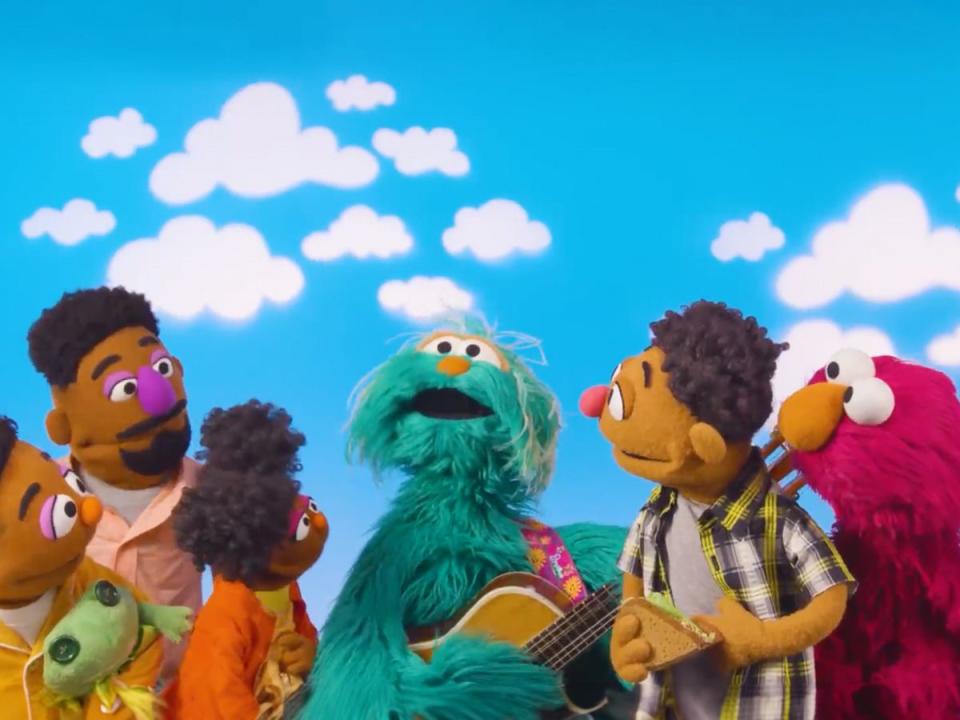Sesame Workshop Continues to Expand Its Emotional Well-Being Resources For Young Children
- Oops!Something went wrong.Please try again later.
In addition to resources already online, Sesame teams up with new partners for new PSAs featuring Elmo and friends.

Sesame Workshop
Fact checked by Sarah Scott
There is some great news for parents who need support or fresh ideas to help their kids understand, talk about, and express their feelings in healthy ways. Sesame Workshop continues to expand its Emotional Well-being Initiative. Sesame Workshop already has a host of resources on its site including videos, articles, digital games, and storybooks to help families take care of their mental and physical health—reinforcing that the two are intertwined.
But now, Sesame Workshop is continuing its efforts through a partnership with the Ad Council and the Huntsman Mental Health Institute for two new PSAs. The first one features Elmo and his Sesame Street friends humming the world-famous theme song. Humming can actually have benefits for people's overall emotional well-being.
Jeanette Betancourt, EdD, the head of U.S. social impact for Sesame Workshop explains they're committed to building the social-emotional development of children because it’s always been at Sesame Workshop’s core, “but now we’re currently facing a mental health crisis.” A crisis, she emphasizes, that was not caused by the pandemic but rather exacerbated by it.
“Sesame Workshop is always committed to filling the greatest needs and we felt very strongly that we needed to really up our response on developing the ‘emotional wellbeing’ of our young children from two points," Dr. Betancourt says. "The first is what do all young children need—and the adults around them need to understand? And the second is how do we start to identify the key things that show some distress in the form of their big feelings?”
Among Sesame Workshop's resources online are four videos with the Muppets of Sesame Street. There's also a digital storybook titled Feelings, Feelings, Everywhere, which explains how everyone has different feelings at different times for different reasons. In the digital interactive game titled I Notice, I Feel, I Can, children learn how to manage their big feelings. There are also printables for children and families plus articles for caregivers and providers. All of these free resources are available in English and Spanish on Sesame's website.
Understanding Emotional Literacy
With Sesame Workshops' new resources, they are striving to teach adults “emotional literacy”—with their child’s perspective in mind.
“The core of emotional literacy is giving the words for the emotions or the feelings that you're experiencing and expressing, or the behaviors you're showing,” explains Dr. Betancourt.
The resources are recommended for parents to review so that when something comes up, such as calming their child down before a big life moment, they’ll know which resource is best to apply and how to utilize it. This includes breathing and calming exercises as well as important communication techniques so parents can model how to express their feelings and talk through them.
One of the resources that demonstrates this is a video of Wes talking to his dad about feeling excited about an upcoming performance yet his “tummy feels funny.” It’s a common scenario that most parents have likely experienced with their child feeling anxious but unable to name the emotion in their “tummy.”
Betancourt believes the beauty of these resources is the way they model the child's point of view so that you're opening up the conversation while giving adults strategies on what to do and say.
“Even as adults, we don't just feel the emotion in our head, it sort of trickles down into our body. And using our body, especially with young children, that really helps as well,” she explains. Dr. Betancourt points out that techniques such as ‘butterfly breathing’ work so well because you do it together with your child. That in turn motivates a pattern of communicating, doing, and responding with feelings.
Overall, Dr. Betancourt says parents must model self-care to their children, citing their “My Body, My Mind” video as a great reminder for adults and children. It illustrates that it’s not just about movement keeping us healthy—it’s getting sleep and eating well—all the things we know as grownups we need to do. But the Sesame way is to reinforce it for grownups and children alike.”

Sesame Workshop
Abby and Alan demonstrate butterfly breathing.An Early Start on Naming Feelings
Sesame Workshop believes it’s critical to start using these tools in the early years of development. By introducing those ideas early on, as children get older, they'll be stronger and more prepared to face challenges and obstacles.
“We know that especially between ages 2 and 5, we have to guide children on regulating their emotions. We also have to provide nurturing connections and the love and care that we have for little ones, but also routines,” Dr. Betancourt explains. “Little ones need steadiness and routines. We also need to keep them nourished both in their mind and body. And then lastly, we must provide children a sense of hope and optimism and a sense of kindness for themselves and others.”
"We must provide children a sense of hope and optimism and a sense of kindness for themselves and others."
Jeanette Betancourt, EdD
Overall, emotional literacy has become increasingly important because young children are being exposed to big issues that they may not understand, even if we try to protect them from those feelings.
“Even prior to the pandemic, there [have] been indications that families as a whole are not only experiencing more stress but in some cases feeling very isolated from one another,” says Dr. Betancourt. “There’s an increase in societal anxiety that’s impacting children and families individually.”
The hope from Sesame Workshop is these resources are used as a family—but also to reduce the stigma for both adults and children of reaching for help outside.
For more Parents news, make sure to sign up for our newsletter!
Read the original article on Parents.

